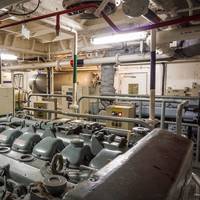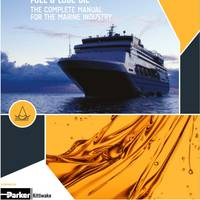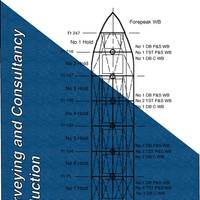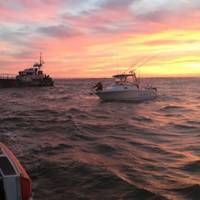NYK's Diagnostic Tool to Prevent Machinery Failure
NYK and MTI Co. Ltd. have jointly developed a diagnostic tool that records, visualizes, and analyzes the operational sounds of a vessel’s engine plant. The tool is one of the group’s big data initiatives to encourage greater safety and has been given the name "Kirari MUSE." Onboard trials will begin shortly. Kirari MUSE comprises equipment for recording and visualizing sounds around the vessel engine plant and software that analyzes the sounds and detects anomalies. More specifically, Kirari MUSE utilizes electrical listening devices to record, accumulate, and share sounds that can then be visualized as data on a tablet. Software then diagnoses the engine condition using logic based on vessel operation experience.
New Guidance: Reducing the Risk of Propulsion Loss

Bureau Veritas, TMC Marine and the London P&I Club have issued a new booklet providing operational guidance for preventing blackout and main engine failures. In a joint project, classification society Bureau Veritas and consultancy TMC Marine, a Bureau Veritas Group Company since 2016, have cooperated again with the London P&I Club to produce the second booklet in a series on loss prevention issues. The new publication focuses on the marine engineering issues and procedures related to loss of propulsion incidents and how to prevent them.
Parker Kittiwake Launches 'The Gold Guide'

Parker Kittiwake has announced the launch of the Gold Guide – a definitive reference guide to fuel, hydraulic, and lubricating oil for the marine industry. This first-of-a-kind, comprehensive resource provides vessel owners and operators with all the information needed to understand all aspects of fuel, lube, and hydraulic oil from first principles to testing, monitoring, characteristics and specifications. Furthermore it gives a comprehensive insight into interpreting test results and understanding the potential impact these can have on operational performance and efficiency.
Marine Surveying and Consultancy – An Introduction

Having been an independent marine surveyor and consultant for many years, author and educator Mike Wall has based his new book Marine Surveying and Consultancy – An Introduction on experience. Primarily aimed at those wishing to become independent marine surveyors and consultants, the book covers many aspects of their work with some covered in depth. Marine surveys are of two types, proactive and reactive. In the former the surveyor inspects a vessel before a voyage or activity to ensure that it meets relevant requirements, standards and/or international conventions.
Boating Fatalities Low in 2015 -USCG

The U.S. Coast Guard released its 2015 Recreational Boating Statistics report Tuesday, revealing that boating fatalities nationwide that year totaled 626, the third-lowest number of yearly boating fatalities on record. From 2014 to 2015, injuries decreased from 2,678 to 2,613, a 2.4 percent decrease; deaths increased from 610 to 626, a 2.6 percent increase; and the total number of accidents increased from 4,064 to 4,158, a 2.3 percent increase. The report also shows that in 2015 the fatality rate of 5.3 deaths per 100…
Boating in US Getting Safer: Coast Guard Report
U.S. Coast Guard releases 2012 Recreational Boating Statistics Report showing the lowest number of fatalities on record, overall drop in accidents & injuries. From 2011 to 2012, deaths in boating-related accidents decreased from 758 to 651, a 14.1 percent decrease; injuries decreased from 3,081 to 3,000, a 2.6 percent reduction; and the total reported recreational boating accidents decreased from 4,588 to 4,515, a 1.6 percent decrease. The fatality rate for 2012 of 5.4 deaths per 100,000 registered recreational vessels reflected a 12.9 percent decrease from the previous year's rate of 6.2 deaths per 100,000 registered recreational vessels. Property damage totaled approximately $38 million.
BV backs S&T Ecomax Tanker Design
International classification society Bureau Veritas and French shipowner Services & Transport have developed an Ecomax tanker design intended to address all the major causes of large oil spills. gear, increased hull scantlings, reduced high tensile steel content, duplicated navigation equipment with off-track monitoring and full inerting of all ballast spaces. "While smaller oil spills are getting less frequent, the occurrence of large spills due to tanker accidents is remaining constant," says Philippe Anslot, technical director of services & transports. "When we looked at the underlying causes of those spills we saw that the four main factors were machinery failure, navigation error, fire and explosion and hull damage.
BV backs S&T Ecomax Tanker Design
International classification society Bureau Veritas and French shipowner Services & Transport have developed an Ecomax tanker design intended to address all the major causes of large oil spills. gear, increased hull scantlings, reduced high tensile steel content, duplicated navigation equipment with off-track monitoring and full inerting of all ballast spaces. "While smaller oil spills are getting less frequent, the occurrence of large spills due to tanker accidents is remaining constant," says Philippe Anslot, technical director of services & transports. "When we looked at the underlying causes of those spills we saw that the four main factors were machinery failure, navigation error, fire and explosion and hull damage.
Intelligent Software Agents for Machinery Diagnostics
Machinery plant maintenance represents a major expense for ship operators. In addition to normal maintenance expenditures, unexpected breakdowns have a significant cost impact. Recognizing the importance of preventing equipment failures, companies continue to adopt automation for machinery monitoring at a rapid pace. Continual improvements in the price/performance ratio of automation systems have also fueled their increased use in shipboard machinery plant monitoring. As a result, more ships with automated machinery plants exist today than ever before. However, just as a typical Internet search can easily create "information overload", so too can process automation create a "data overload" situation for the engineering crews responsible for equipment operation and maintenance.
BV backs S&T Ecomax Tanker Design
Innovation on the tanker front comes from many venues, and one of the latest — the Ecomax tanker design — is offered from the minds and experience of a pair of French companies, classification society Bureau Veritas and shipowner Services & Transport. The new Aframax tanker design is intended to address all the major causes of large oil spills, and features two independent engine rooms, power supply systems and steering gear, increased hull scantlings, reduced high tensile steel content, duplicated navigation equipment with off-track monitoring and full inerting of all ballast spaces. "While smaller oil spills are getting less frequent, the occurrence of large spills due to tanker accidents is remaining constant," says Philippe Anslot, technical director of Services & Transports.
Feature:There's Something About Mary
The long and illustrious tradition of glamour associated with transatlantic liners is set to continue when Queen Mary 2, owned by Cunard and classed by Lloyd's Register, leaves the port of Southampton for Fort Lauderdale on its maiden voyage in January 2004. After this first voyage, Queen Mary 2 will sail the traditional transatlantic liner route from Southampton to New York City for which it was specifically designed, although the ship will, over its lifetime, play a dual role as both liner and cruise vessel. Upon completion in December 2003, it will be the largest, tallest and fastest passenger vessel of its type yet built in the world, at a height of 236 ft. (72 m), a beam of 134.5 ft. (41 m) and a length overall of 1,132 ft. (345 m).





